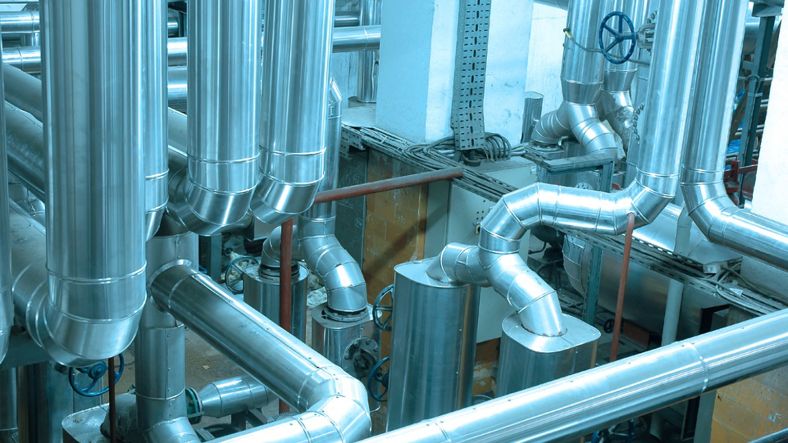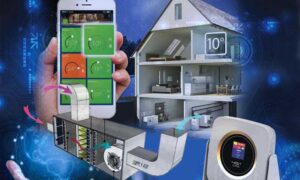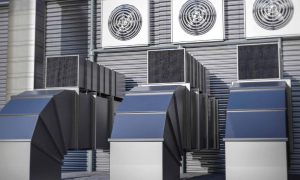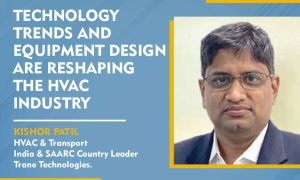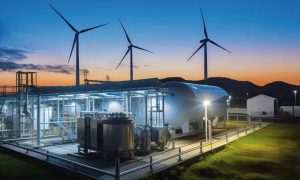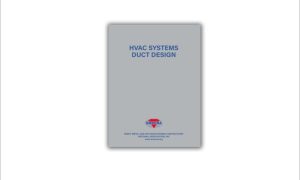Leading industry experts shared perspectives on enhancing thermal technologies for indoor spaces; comfort in public spaces deliberating upcoming trends, design initiatives, best practices and a lot more.
Pandemic made us learn to upkeep hygiene along with temperature control of indoor public spaces. The demand for thermal control solutions and systems in HVAC sectors, managing IAQ for end-use industries such as healthcare, automotive, malls and supermarkets; libraries and museums; servers and data centres; railways and airports, are all leading the growth of thermal control management market with increasing use of electrical devices. The global thermal management technology market is estimated to be USD 12.8 billion by 2025 from USD 8.8 billion in 2020 at 8.2 CAGR.
The growth of the thermal control technology market is fueled by rising demand for thermal management solutions and systems for use in consumer electronics; increasing use of electronic devices in different industries, and ongoing electronic miniaturising.
For discussion insights, Thermal Control Business Update conducted an interactive session on “Thermal Control Technologies for Public Spaces.” The distinguished speakers Aneesh Kadyan, Senior Executive Director, CBRE South Asia Pvt Ltd.; Ashish Rakheja, Managing Partner, Aeon Consultants; Kaustubh Dev, Regional Head (Product Manager), Testo India., and Pravin Rawool, Asst. Vice President & Head – MEP & Internal Services, Godrej & Boyce who participated in the panel discussion revealed challenges and opportunities, trends and techniques and an optimistic future for HVAC industry growth.
Innovative HVAC control technologies and instruments for monitoring IAQ
For monitoring IAQ for occupants in large public spaces such as airports, malls etc., the monitoring of various parameters are a headache for the technicians. So nowadays, many different instruments are available, which are smart enough. Kaustubh remarked, there are so many different instruments available in the market that can be used for the ease of operation and can have a precise measurement of indoor air quality and HVAC related parameters. Instruments now have app connectivity; you can control the instrument through your smartphone. You can report generations also with the help of the smartphone. We have inbuilt digital camera instruments in our smartphones. So even you can have a photograph of the locations where you are going to use these instruments.
For connecting the Testo flow hood with a mobile phone, Kaustubh replied there are many instruments which can be connected and yes, Testo Hood is one of them, you just have to download the free app from the Play Store. It is for different instruments, the apps are different for functions; we called it a testo 420 volume flow hood. You can download and generate a report also. You can have many controls; you can mount the testo capture Hood on a tripod and can have a measurement sitting in a safe location. So that is possible. The testo 420 air capture hood is for larger air inlets and outlets that enable fast and precise compliance with hygiene guidelines and requirements concerning room air quality.
Design initiative in HVAC systems for occupants-specific public spaces
A well designed large public space or building requires a healthy environment. While talking about commercial buildings, designing techniques and indoor air environment across the Indian demographic, Pravin stated, when we talk about a healthy environment there are many parameters. And, one of them which are important is – the air and when we feel about air, we touch upon ventilation and there is something called the particulate matter. Of course, there are standards like ISHRAE, ASHRAE, WHO etc. Such institutions have standards which any designer has to consider while designing the ability. About ASHRAE 62.1, it talks about cfm per person or 0.06 cfm/sq. ft. It outlines minimum ventilation rates and other measures intended to provide IAQ that is acceptable to human occupants and that minimises adverse health effects. These parameters are mentioned in the standards. What we have seen is that when the Covid situation has come, we had to pick parameters like 0.06, so that we can have better air change per hour and we have at least 6 to 10 cfm in the room. So, we know that we have to be flexible depending upon the condition we need to factor in, while designing the air conditioning systems. And apart from that, there are other initiatives like depending upon the external environment rather than taking normal fresh air. So, can you treat the fresh air? Can you go for an energy recovery bill depending upon the quality of air which we are taking inside so that optimum energy efficiency can also be achieved.
Whatever is required can be achieved in that and for the variable air volume, which we generally use; the demands for control diffusers are also nowadays available, which can also be incorporated. So these are all measures that can be added, apart from the standard designs.
Increase in running cost and pollution content of places Expanding further, Aneesh remarked, I would like to share two things. One is that one needs to just understand that because of the Covid, the occupancy in buildings has come down. So the heat load which is there actually comes down. So there’s going to be a trade off. Yes, you’re getting more fresh air. So there is an increasing cost because you are treating more air.
To this Ashish added, I just want to add one more thing, if you look at the recommendations that ISHRAE and ASHRAE have got: they also say, raise the indoor temperature, and you can take it to 26-27 degree C. If you are taking a penalty on the energy front by bringing more fresh air, even if you have got the same occupancy, it is worth it; and in a worst case scenario, you can have the same thermal comfort being done as some alternate option. So it is about how you tackle it.
Best practices to ensure health safety HVAC strategies must be instituted to create comfort in large public spaces.
Aneesh said, when the pandemic started, there was a lot of discussion, especially in the ISHRAE circles, about how to go about it and what to do about this. And, I recall Ashish of course was there in the forefront and a lot of other leading members of ISHRAE were also present. One of them had actually brought a very good point that if we just follow the basics of air conditioning, that itself will solve a lot of problems.
So, good air conditioned design does say that you have to have a certain amount of fresh air coming in, because it’s good for human comfort and health and all that stuff. I think the first strategy that people should look at, especially OEM teams and people who are running buildings and public spaces – to see what was the original design and go as close to that as possible, wherever it is possible.
Adding further, Aneesh said, the other aspect that I think everybody should consider is to train the people, the ones who are operating and maintaining systems, to see that they follow the processes that are there; then you have made a process. So people just learn on the job, we do not have so much formal education. So these people really have to be trained really.
So these are the two areas which I feel are very important: training and awareness, among the people who are maintaining and operating those systems. And of course, being close to the design the air flows etc., is supposed to be there. Sometimes, when a new store opens up in a mall, the ventilation flows change. And because of that, there’s some hot spots, cold spots, you’re not supposed to have those in a properly air conditioned space. So I think if people just follow those, we should be in a safe space, remarks Aneesh. Certainly, increased footfall at public spaces, including in malls and theaters, is going to be a major concern.
To a query by a delegate- is demand based ventilation would be the best solution, and which state is taking necessary steps or concerns in this regard, especially in the post Covid scenario?
Addressing the raised query, Pravin said that demand based ventilation is a really great solution. Because generally when we talk about ventilation, we measure it in terms of air changes per hour, and we look at how many times the entire air can be replaced and the return air is mixed up with the treated fresh air from outside as Ashish also mentioned, depending upon the external environment condition, we need to treat it and mix it.
Now to correlate based on the volume and the density of the occupant, use the adequate controls to regulate and monitor or adjust the damper so that the percentage of air with content inside can be regulated, then it gives you a better control. Yes, there are guidelines. Now, when we are opening up, maybe in terms of occupancy and the standards; we are talking about the temperatures and the relative humidity, which is mostly coming from the healthcare facilities.
Specifically, if I talk about indoor air quality; earlier there were certain incentives which were provided by the government, especially for the green buildings, when a developer was wanting to go for a green building. And when you talk about green building, it covers all the aspects; it covers the indoor air quality and the other aspects.
But again, those kinds of incentives, they can at least push the developers from a green and sustainability point of view, and pushing these kinds of incentives will help. But definitely, there are good returns. Any developer who is today going ahead with this kind of green environment, wellness certificates are there. If it’s there, then they get a good return on investment on what they are doing.
Market growth for sensor instruments in current times
Monitoring indoor air quality in public spaces involves sensors, instruments that provide data to find measures and regulate temperature with regard to occupants’ density. Addressing market growth, Kaustubh sounded positive saying that there is a good scope in the near future as one of the panelists already informed us that we are from the part of the world where a majority of time in the year, the temperature is slightly elevated than the normal temperature. There are also many other infrastructure projects coming up in India. Hence, there is a good scope of HVAC parameter related sensors in our part of the world.
Secondly, there are many sensors which are permanently installed in HVAC&R system. So, those sensors keep their part in running the system. Similarly, the portable measuring instruments also play its part because many times we have to check the online instruments, whether they are functioning as per the standards, or it needs to be recalibrated. Many times it is not possible for the users to send it to the lab for recalibration. So in that case, the portable sensors also play its part.
Yes, the future is very bright, and we hope to get a good mileage in the near future for these kinds of sensors.
Energy challenges impact thermal control market impacting economy
Ashish remarked, any construction that takes place, obviously impacts the market for sure. We are constructing multiple things at a fast pace. Given that fact, there will always be demand for water and infrastructure. And you know, there is scarcity around and that is about to happen. Even though we are building the power plants, we are bringing the rivers closer to the cities, but then the scarcity remains because the construction phase is fast. That is one way of looking at it. Secondly, one can also say that we have been fortunate that our construction industry started along with the green building movement in India. So, a lot of buildings that have been constructed as townships, projects are being constructed responsibly. This is not what a lot of developed countries can talk about or even China when we speak about it, they did not have the green movement, which coincided with the construction movement. es, our buildings have been done correctly. If you look at the third part, some of the people say that 70 percent of India has to be rebuilt, and the next 10 years are crucial. This is the time when we have started speaking about low carbon development, we are talking about concerns and decarbonising our construction sector. The next billions of sq. ft., of construction we are doing with the low carbon techniques. So, construction is bound to happen.
Recovery of the HVAC market in India in post pandemic scene
Aneesh said, I would say in the HVAC market, my core involvement is in the building space, it’s going to be tightly linked to the way the economy recovers, and more importantly, the commercial office space recovers. I think the general industry trends are showing things are in the positive direction right now, especially residential. There is more uptake on residential, and there will be a requirement for air conditioning in that space. So, that is a personal opinion that we the industry will see good days, sooner than later.
Addressing the issue Ashish observed, let me put it this way: There’s nothing wrong with the HVAC industry. It is only regional; it is only sector wise that you see up and down. So whereas the commercial is a sector where the uncertainty has crept in; on the other side, if you look at the stories going around with the CBRE report, etc., they mention that most of the big cities have run out of the existing stock of the residential that they had.
And it is time to construct more. And you can see that if you go to the southern part of the country, Hyderabad is booming. On one side, other sectors are coming up. And if you look at the other way the number of hospitals are coming up, the infrastructure, the airports, railway stations, etc. There is a huge pace of construction of the highways and infrastructure. A new sector is coming up, and that is data centers. We forget this pandemic was a new recovery or a rather new insight into the data center industry, we now have so many data centers that have come up. So the industries or the manufacturers or groups that started looking at the newer areas, there is no shortage. But yes, the conventional market stayed there, adds Ashish.
Future concerns
We are doing MEP in these segments; the commercial segment was growing at 30 percent, said Pravin. Today, if you see it has de-grown, but during the Covid times. The vacancy rate is safe, but the absorption is good. And there are certain tier I cities where we could see good development. So that is going to push the HVAC industry. Second data center has been growing like anything. And one gigabyte of development is a huge development in the next five years, which is going to come across the entire tier I, tier II cities. So, these are the two areas where we could see a good development and a good growth coming in – apart from other areas where again only the ventilation growth is happening. With e-commerce booming up, the warehouse sectors are also coming up in a large scale where ventilation is again picking up because these are all A-Grade warehouses which are huge in footprint, where it requires mixed kinds of ventilation which is naturally enforced. So these are things which are going to drive the market.
Kaustubh remarked, there are almost all the sectors we have seen growth coming from and in fact even for cold storage, infrastructure development is huge and the government is supporting it. We have seen in Gujarat also now they are coming up with a burst in the fully AC market. Obviously, lots and lots of opportunities are there for the HVAC industry.
The way ahead
The exchange of indoor and outdoor air is imminent in public places and buildings. The importance of a healthy environment inside is an emerging issue. Ashish observed, I think it has been a great session. We touched upon the issues from manufacturing to contracting to even the operations side of it. No doubt, we do have challenges ahead, we all wish the pandemic would get over but I think if it is around for some more time, we need to continue with this cautious approach. Just keep in mind that – at times, the health and well being of the people has to take precedence over energy alone. So these are testing times, new times, unchartered territories and we as part of the building industry have to keep finding the ways. I think it is the panel like this which brought the thought leaders together. It brings out the ideas and brings us suggestions which are important for not only me as a designer but everybody as an entire industry and all stakeholders benefit by that.
But the most important is whatever construction we do, whether in a private or in a professional capacity, let’s do it the right way, constructing rightly, following the fundamentals. So, keep the fundamentals in mind that indicate what the healthy buildings and the good buildings are all about. You should probably have the right thermal comfort, all you need to do is stick to fundamentals and you cannot go wrong and this is what the pandemic has taught us that wherever we took shortcuts, today we are ending up rectifying those.
On a conclusive note, Ashish said, if we have to keep India on the right path, if we have to keep it as a sort of a role model for what the built environment should be like – stick to the fundamentals, stick to responsible construction. And believe me; we will not have the challenges that others have in terms of energy crisis or the resource crisis, if we continue to construct and if we do the construction responsibly.
Cookie Consent
We use cookies to personalize your experience. By continuing to visit this website you agree to our Terms & Conditions, Privacy Policy and Cookie Policy.

